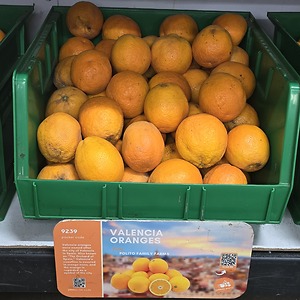


Valencia Oranges
Estimated Inventory, 88 ct : 0
Description/Taste
Valencia oranges are medium to large in size, averaging 7-10 centimeters in diameter, and are round to oval in shape. The thin rind is golden orange with a rough, leathery texture due to many prominent oil glands that contain fragrant essential oils. Underneath the surface of the rind, the white, spongy pith clings tightly to the flesh making the fruit somewhat difficult to peel. The yellow-orange flesh is tender, extremely juicy, contains 1-6 cream-colored seeds, and is divided into 10-12 segments by thin membranes. It is important to note that sometimes a Valencia orange may go through a regreening process, which is when the fruit reabsorbs chlorophyll giving it hues of green even though the fruit is fully ripe. Regreening does not affect the flavor of the orange, and when ripe, Valencia oranges have a balanced, sweet-tart flavor.
Seasons/Availability
Valencia oranges are available in the spring through summer.
Current Facts
Valencia oranges, botanically classified as Citrus sinensis, are a sweet orange variety that grows on evergreen trees and is a member of the Rutaceae or citrus family. Also known as the Summer orange, there are at least fifty different known sub-varieties and hybrids of the original Valencia orange in existence, and this orange is often regarded as one of the most popular varieties in the world. Valencia oranges are a late-season variety that are the only oranges to ripen in the summer. They are favored by chefs and home cooks for their sweet-tart flavor and juice. The juice is so popular that Valencia oranges account for over half of Florida’s citrus cultivation in the United States and the majority of the Valencia oranges grown are used for juice production.
Nutritional Value
Valencia oranges are an excellent source of vitamin C, fiber, and folate. They also contain antioxidants that help boost immunity.
Applications
Valencia oranges are most commonly utilized for their juice but may also be used in raw or cooked applications. The juice can be used for marinades, syrups, vinaigrettes, cocktails, custards, or to flavor sauces for cooked meat dishes. The juice and zest can also be used for baking to flavor cakes, cupcakes, bread, crème Brulee, tarts, and pancakes. When used raw, the flesh can be segmented and served drizzled in honey and bee pollen tossed into green salads, grain bowls, fruit bowls, or garnished over fish. The segments can also be dipped in chocolate, or the rind can be candied and served as a sweet, tangy treat. Valencia oranges pair well with asparagus, snap peas, brussels sprouts, broccoli, fennel, feta cheese, gorgonzola cheese, black tea, ginger, cardamom, thyme, cranberries, apples, roasted beets, olives, pistachios, and pecans. The fruit will keep 2-3 weeks when stored in the refrigerator.
Ethnic/Cultural Info
Valencia oranges were named after the city of Valencia in Spain. Also known as “The Orchard of Spain,” Valencia’s coastline is covered in orange trees, and the orange is regarded as a symbol of the city. Valencia oranges are commonly juiced and served during breakfast. The juice is also used in the local cocktail Agua de Valencia, which is a mixture of orange juice, spirits, sugar, and cava, and is traditionally served in liter containers, poured into champagne glasses. When served fresh, the oranges are sliced and served as a dessert with a sprinkle of cinnamon. In addition to culinary uses, the blossoms of Valencia orange trees are often used in bridal bouquets as a symbol of love, and the branches are burned to flavor paella. Valencia oranges also played a significant role in Southern California as they were the variety that initially jumpstarted the citrus industry and by 1915, there were over 20,000 acres of orange groves planted across Southern California. This area today has now been largely developed into urban communities, but to commemorate the success of citrus, the region was named Orange County.
Geography/History
The origins of the Valencia orange are somewhat disputed with some experts believing the orange came from China and was popularized in Valencia, Spain, while other experts believe it was popularized in California in the 19th century. Despite the disputed origins, Valencia oranges are a widely cultivated variety and can be found at local markets and specialty grocers in Spain, Morocco, South Africa, Brazil, Mexico, and Florida, Texas, and California in the United States.
Recipe Ideas
Recipes that include Valencia Oranges. One
Podcast

















